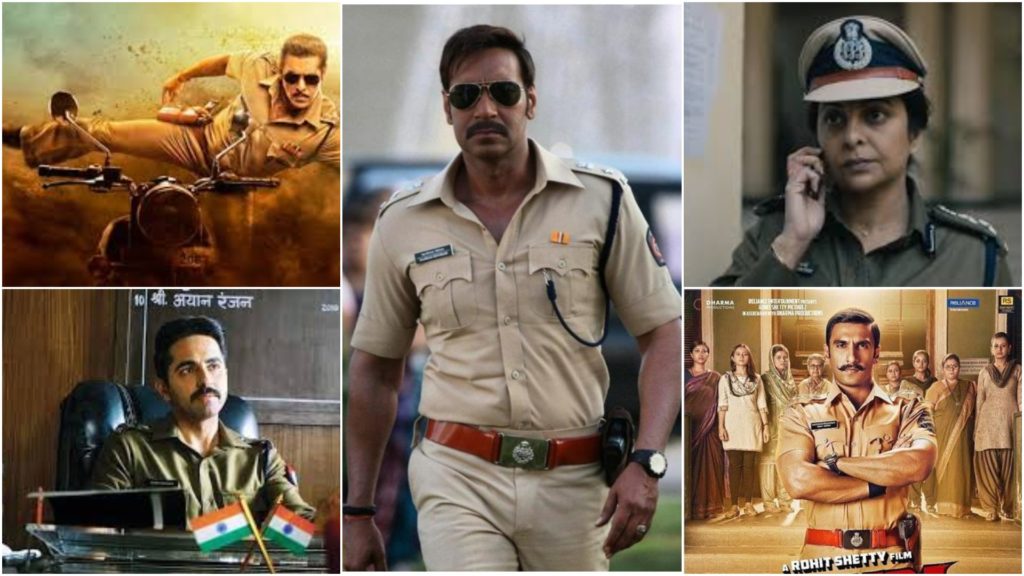Representation of police in Indian entertainment industry
Crime and courtroom dramas are quite popular on Indian entertainment platforms that are also enjoying commercial success on big screen and high TRPs on TV shows. A study was conducted by IBM in which they coded 4,000 Hindi films and found that ‘honest police officer’ is one of the most common introductions for a male character in Bollywood.
Whenever a Bollywood movie with the protagonist playing the role of a police is announced, the image created in front of us is that of a person dressed in khaki (colour of the uniform) with dark glasses and maybe a moustache or something defining him, who can beat up 50 people at a time without breaking a sweat! The films like Dabaang, Singham, Simmba have propagated the Super Cop image of the police and have even gone to glorify mob justice and the way the police characters take law into their own hands to meet justice.
In a study titled Crime and Punishment in Indian Entertainment by Civic Studios, a Mumbai based production house, they did a qualitative analysis of over 30 crime and courtroom dramas in Indian films, television shows and web series from 2016 to 2019. The study showed that the highest form of crime shown on screen is vigilante killings (37 pc), followed by murder (20 pc) and kidnapping (11 pc). The portrayal of justice is quite significant for audience and if it comes with vigilante justice, so be it, even if it has a cathartic effect on them. The viewers of the movie Simmba had greater support (35 pc) for police using vigilantism and fake encounters to catch culprits than non-viewers (25 pc), as found in the follow-up study done by analytics and consulting firm Ormax media in Mumbai.
Salman Khan’s character Chulbul Pandey in Dabaang may be marked as the police character who brought out this larger-than-life image of police with his crass loudness, corrupt ways and innuendo filled dialogues, and has been enjoying the audiences’ cheers even with the third movie of the series. Then comes the righteous cop Bajirao Singham played by Ajay Devgn who solves all problems informally without even filling charge sheets, beats groups of goons black and blue single-handedly, goes against corrupt politician and cripples the entire criminal empire. Then comes Sangram Bhalerao of Simmba, who transitions from a corrupt cop to good cop in the movie and is the most recent film to advocate vigilante justice.
At a panel discussion in Mumbai discussing the real-life effects of reel descriptions of police force, Neeraj Ghaywan, a national award winning director said, “There’s the rude, aggressive, honest cop, the corrupt cop, the flamboyant hero cop. These three roles exist. I want to bring in some nuance, some humanisation to the custodians of justice and the perpetrators of crime. We villainize them and we’re asked to do so in Hindi cinema.”
Hussain Zaidi’s book Class Of 83 explored the negative perception attached to the police and looked at the encounter specialists of Mumbai police who were active during the 1980s and 90s. “There’s a certain police psychology we should all know about. They get nervous, sometimes they get scared in public. They are as human as we are, the khaki uniform doesn’t make them all-powerful or all-potent,” he said in a conversation with an Indian media.
The Civic Studios study explored five ‘honest/righteous’ police characters from their 30 selections where they found that for audience an honest cop does not always translate to honest institution. Among these five, Sartaj Singh from Sacred Games and Ayan Ranjan from Article 15 are fighting against their corrupt superiors to bring justice while the character of Vartika Chaturvedi from Delhi Crime struggles with her understaffed and inefficient police force.
It seems not many cops are going to play by rule-book on big screen while on TV shows not many shows deal with the challenges faced by the police force. However, what the Indian audiences need to see is a mature characterisation of the police force in the films and not as some demigod who is beating hundred goons single-handedly.










